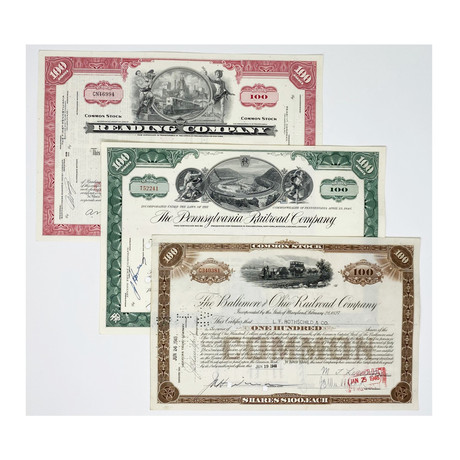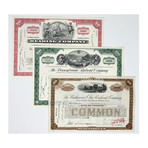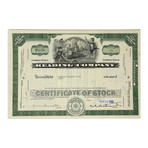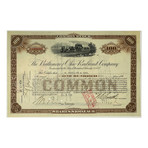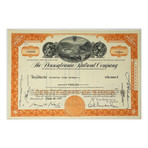Olevian Numismatic Rarities
Monopoly Game Railroad Collection: Set of 3 B&O, Pennsylvania, & Reading Railroad Stock Certificates (1940's - 1970s)
Product Description
This fun set features three different stock certificates issued by the railroad companies featured in the classic game Monopoly: . Pennsylvania, B&O, and Reading. The 4th railroad in the game, the Short Line, was not an actual railroad. The board game is based on the property and real-estate landmarks of Atlantic City, New Jersey, and although these railroads were all major players in the region often engaged in their own monopolistic business practices, some did not actually serve the coastal beach resort town directly.
The venerable Pennsylvania Railroad sometimes referred to as the “Pennsy,” has been heralded "The Standard Railroad of the World." The original line connected Philadelphia and Pittsburgh, but the tracks of the Pennsylvania ultimately served a region bounded by New York, Chicago, St. Louis, and Washington, D.C. In terms of traffic, the Pennsylvania was the busiest railroad in the world for many years. The Pennsylvania did serve Atlantic City, through a subsidiary that was controlled 50/50 with the Reading known as the Pennsylvania-Reading Seashore Lines. In 1968, it merged with the New York Central and became the Penn Central. The Penn Central was later acquired by Conrail, and ultimately by Norfolk Southern Railway. The Pennsylvania remains one of the most popular railroads among modelers today.
The Baltimore & Ohio Railroad, or B&O Railroad, was originally chartered to build a line connecting the port of Baltimore to "a suitable place" on the Ohio River. Its construction in 1827 marked the first public charter for a major common-carrier railroad. The state of Maryland later gave the B&O a charter to build a line from Baltimore to Washington, D.C. From these beginnings, the B&O grew to serve much the same region as the Pennsylvania Railroad. The B&O and Pennsylvania were bitter rivals, particularly in the Pittsburgh region where the Pennsylvania legislature itself had blocked the B&O from securing earlier routes into the region to protect the PRR. The two also competed on nearly parallel lines from Jersey City to Washington. The B&O did not actually serve Atlantic City, but it owned a controlling interest in the Central Railroad of New Jersey, which did. Like the Pennsylvania, the Baltimore & Ohio operated for over a century. In 1963, it became a part of the Chessie System, which ultimately merged with the Seaboard System Railroad to become CSX.
The Philadelphia and Reading Railroad, later the Reading Company, was originally chartered to build a line between Reading and Philadelphia, Pennsylvania. The "RDG" only served Pennsylvania, Delaware, New Jersey, and Maryland but made huge profits by hauling coal from mines to cities throughout these states. Though relatively small by mileage, the Reading was the largest corporation in the world by revenue at one time thanks to its huge mining interests. This power would bring about new government regulations concerning the monopoly on trade for companies owning both the mines and the railroads serving them. In 1976 the Reading Company sold all its railroad holdings to Conrail, including the Pennsylvania-Reading Seashore Line, which did service Atlantic City.
The Short Line railroad in the Monopoly game was not named after a real-life railroad. The game's inventor is reputed to have had a small interurban tram line, the Shore Fast Line, in mind when he named the game property. The term short line applies to any independent railroad with tracks covering only a short distance or small region. While many such railroads have been bought by larger concerns or simply gone out of business, they are far from extinct. Today, the non-profit American Short Line and Regional Railroad Association (ASLRRA) has over 400 member railroads which together operate 29 percent of the railroad tracks in America.
A stock certificate is a physical piece of paper representing ownership in a company. Stock certificates include information such as the shareholder name, number of shares owned, date issued, an identification number, and usually a corporate seal and signatures. Unlike a stock, a bond is a fixed income instrument that represents a loan made by an investor to a borrower, typically a government or corporation, to finance projects and operations. A bond certificate includes the loan terms, bond holder, principle due date, number and value of interest payments, and usually a corporate seal and signatures. Many vintage bond certificates also include attached interest payment coupons, which needed to be physically cut off the bond and redeemed for each interest payment.
Throughout history, companies competed to produce the most impressive stock and bond certificates, with brilliant colors, intricate designs, and beautiful vignettes. However, with the rise of the internet and online brokerage firms in the 1990s, the need for physical certificates disappeared. One by one, companies quietly discontinued issuance of their paper stocks and bonds. A newsworthy example was Walt Disney's decision in 2013 to phase out their colorful stock certificates featuring renditions of their beloved animated characters. The eventual demise of the stock certificate ends a tradition that extends back at least 400 years, when the Dutch East Indies Company became the first company to issue certificates. Today, the beautiful stock and bond certificates that remain are enduring relics from a bygone era in American financial history.
The expert staff of Olevian Numismatic Rarities unconditionally guarantees the authenticity of every historic document we sell, and all signatures contained therein. A certificate of authenticity will be included with each item. Shop with confidence and discover why people choose Olevian Numismatic Rarities when it matters most.
Product Details
- Measurements
12"L x 8"W x 0.1"H
- OriginUnited States
— Includes Certificate Of Authenticity
— Housed In Archival Quality Acetate Protective Sleeve, Ready For Safe Storage, Display, Or Framing
— Each Stock Roughly Measures 10"L x 8"W
Please Note: The item you receive will match the quality of the one shown, but may vary slightly due to the nature of original historical documents. All corporations listed will be included but colors and styles may vary. Stocks and bonds may be neatly stamped and/or punch cancelled and are no longer negotiable. Bonds with payment coupons may have variable numbers of attached coupons remaining.
Shipping Information
-
Shipping AvailabilityCanada, United States
-
Shipping PolicyStandard Ground Shipping
-
Ship In2-3 weeks ⓘ
-
Return PolicyFinal sale, not eligible for return or cancellation
